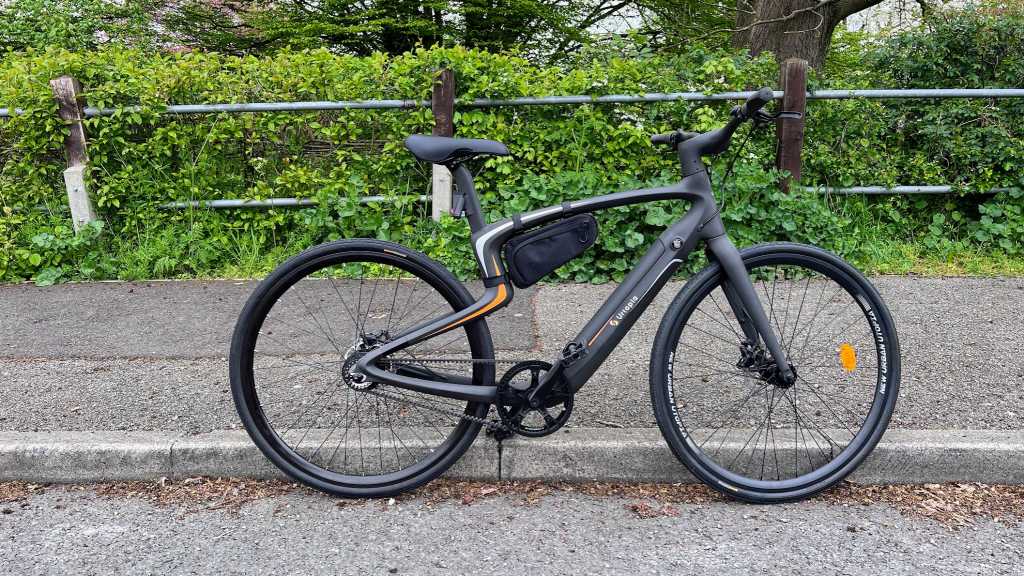Expert’s Rating
Pros
- Fairly lightweight
- ‘Find my bike’ with GPS & eSIM
- Frame design stands out from the crowd
Cons
- Too big for shorter riders
- Virtually no adjustability
- Projection indicators aren’t visible
Our Verdict
The Carbon 1 is a great-looking bike, but the carbon fibre doesn’t make it lighter than some aluminium bikes and a lot of the tech just isn’t as good as it could be.
I first heard about the Urtopia Carbon 1 way back in August 2021, and was offered the chance to test a pre-production model without some of the smart features. I declined, opting to wait until I could get hold of a bike with all the features, because the main focus here is on all the tech.
For various reasons including customs strikes and shipping errors, the wait turned from months into years, but in March 2023 the Carbon 1 finally arrived at my door.
A combination of new, urban and utopia, New Urtopia is a new name in electric bikes. The company’s aim is to provide urban dwellers with a greener, more innovative way to travel and it’s clear that the Carbon 1 is laser focused on being a smart city bike for commuters.
Features & design
- Carbon frame, forks and handlebars
- Belt drive with rear-hub motor and torque sensor
- Built-in screen, speaker & lights
Designed by Mathis Heller, who also worked on BMW’s i-Series cars, the Carbon 1 seems determined to make a good first impression even if that means compromising on some of the practicalities.
For example, the striking ‘lightning bolt’ top tube and seat stay makes the frame really stand out. But this makes the seat tube very short so there’s not a lot of room for adjustment.
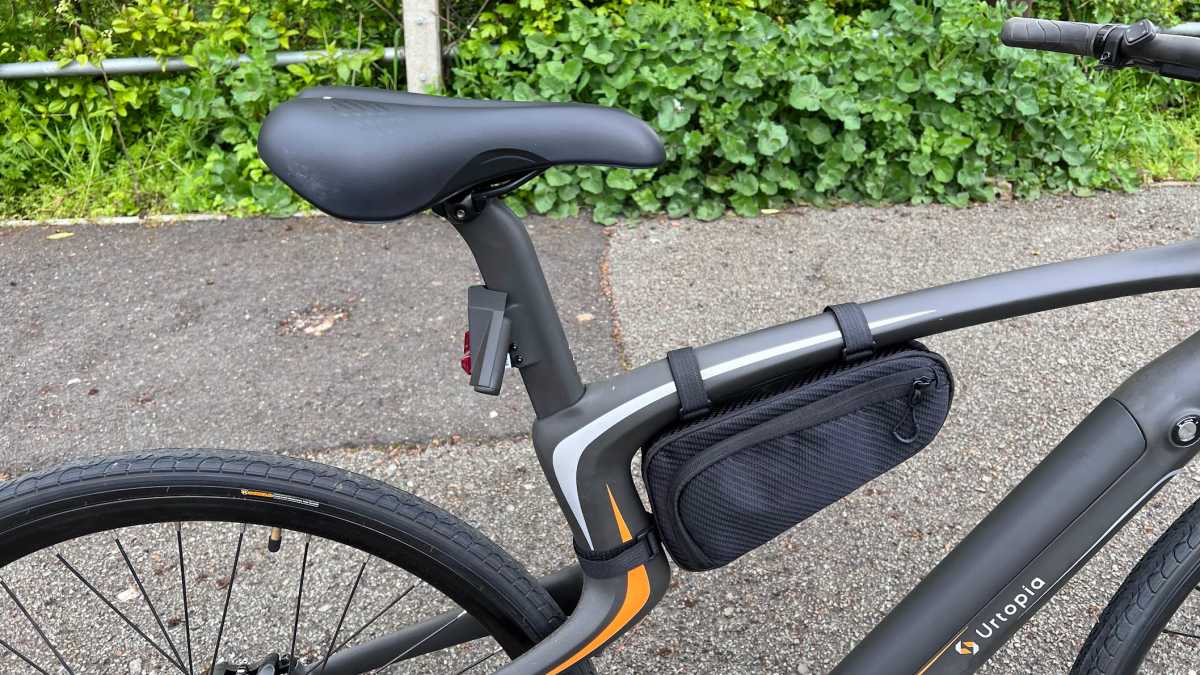
Jim Martin / Foundry
This, in turn, means you have to be the right height to ride the Carbon 1. Urtopia offers two frame sizes: medium and large but even the medium requires you to be at least 5ft 7in (170cm) tall.
That’s fine for most men, but it rules out anyone shorter, including a lot of women.
The striking ‘lightning bolt’ top tube and seat stay makes the frame really stand out
When you think of carbon fibre you probably think of exotic cars and, probably, the visible weave. That’s not something you’ll see on the Carbon 1 which has a smooth matt grey finish, and you get to choose the highlight colours when ordering.
Part of the unusual design is the one-piece ‘Smart Bar’, a handlebar which incorporates a gamepad-style four-way direction pad and, on the right, a circular button with an integrated fingerprint sensor.
In the centre is a large dot-matrix LED display and, in front of it, a built-in LED headlight. Beneath the light is a 3W speaker which emits the sorts of sounds you might expect to hear from a child’s toy when you change power modes and turn the bike on and off.
You can change those sounds in the companion app, but only from a limited selection. Fortunately, you can turn them off entirely and instead feel vibrations through the handlebars when you change mode or use the indicators. Through the app you can adjust the intensity of the vibrations.
The speaker can also play audio from your phone over Bluetooth. This uses a separate Bluetooth connection from the app, so it appears as a separate device in your phone’s Bluetooth menu.
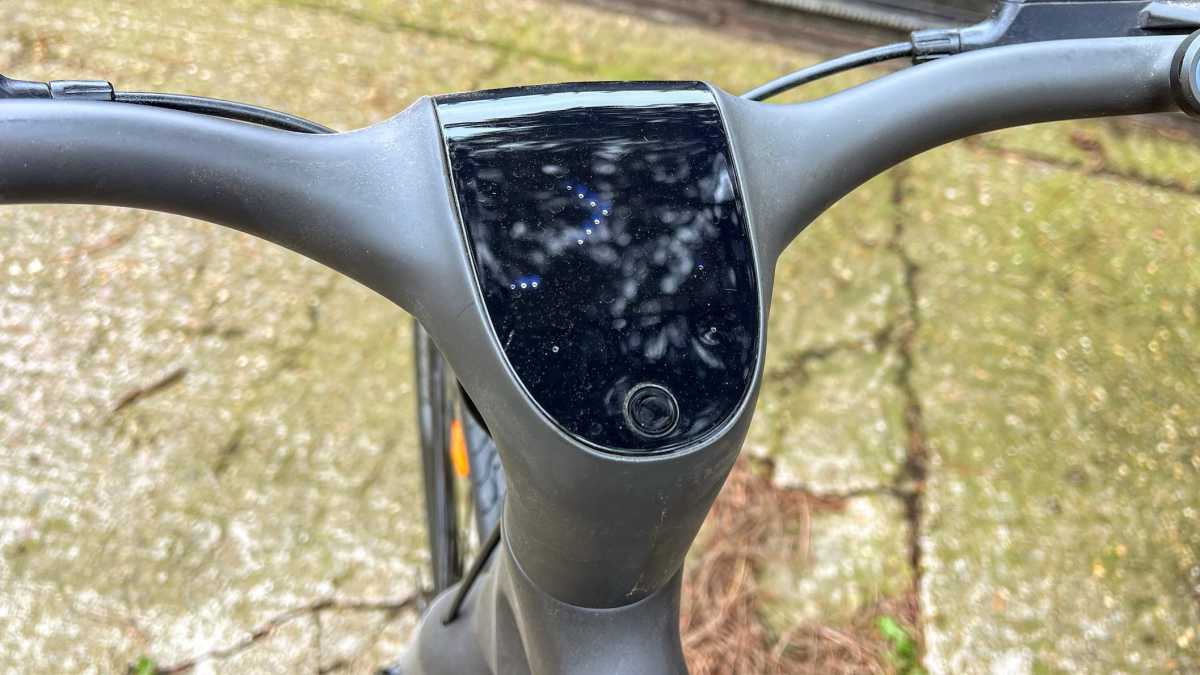
Jim Martin / Foundry
The display can show basic directions, synced from the Urtopia app. The trouble is, the display is low resolution and can’t show much information. All you get is an arrow pointing in the direction to take: no map or road names. Given how high-tech the bike is, it’s really odd that Urtopia decided not to put a phone mount anywhere on the bike, nor a USB port to charge it up.
The display is low resolution and can’t show much information
The display shows your current speed in huge numbers, a rough battery level (not even the percentage) and a number for the assistance mode selected. That’s it: there’s no trip distance, average speed or anything you’d expect even a basic cycle computer to show. It’s a definite case of form over function.
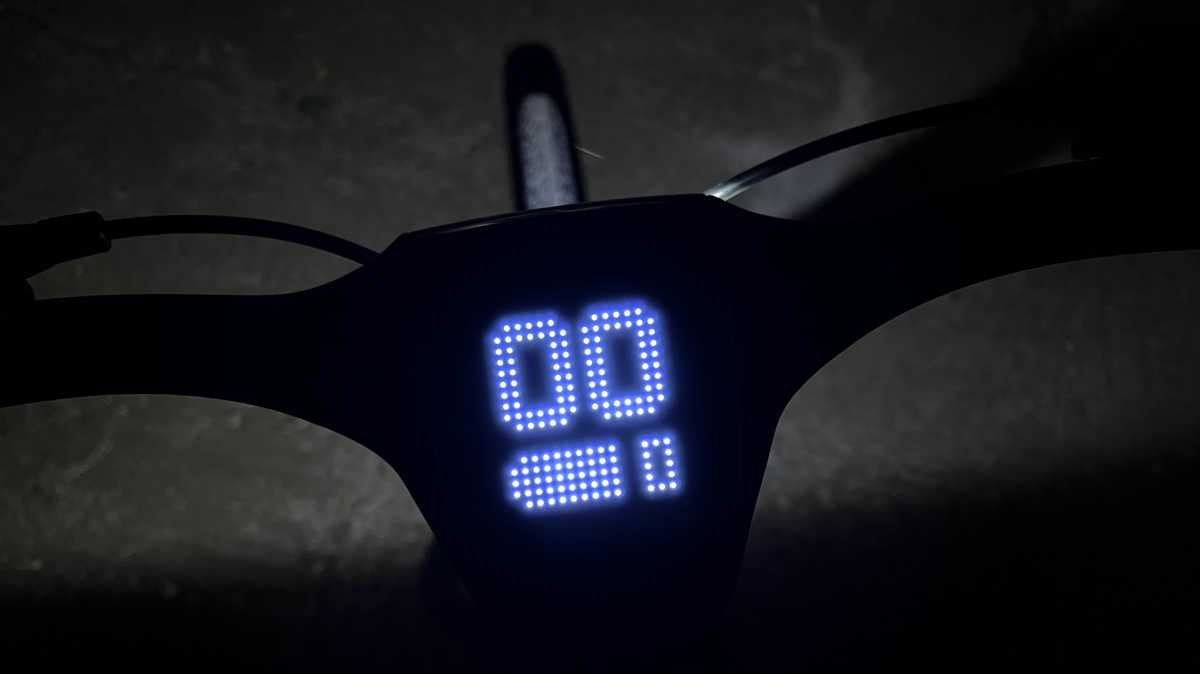
Jim Martin / Foundry
Other built-in tech includes Wi-Fi (for firmware updates) and – most usefully – an embedded SIM and GPS. This means you can track the Carbon 1 if it’s ever stolen. The idea is that you go to the location shown on the map, then connect to the bike when it’s in Bluetooth range, at which point you can turn on the lights and sound the siren to identify exactly where it is.
Unlike VanMoof’s Bike Hunters, Urtopia doesn’t offer any assistance so you should call the police rather than attempt to recover the bike yourself.
VanMoof’s S5 and A5 also go one better with their integrated kick-lock that physically stops a thief from riding off on the bike: there are no physical anti-theft measures on the Carbon 1, so you’ll need to provide your own locks.
The Carbon 1 is cheaper than the S5 and A5, but it’s a shame that a kickstand and mudguards aren’t included: they’re optional extras, as is the water bottle holder and rear rack. Plus, the pedals are just about the cheapest plastic parts available: perhaps Urtopia assumes you’ll never fit them and use your own clip-in system with cleats.
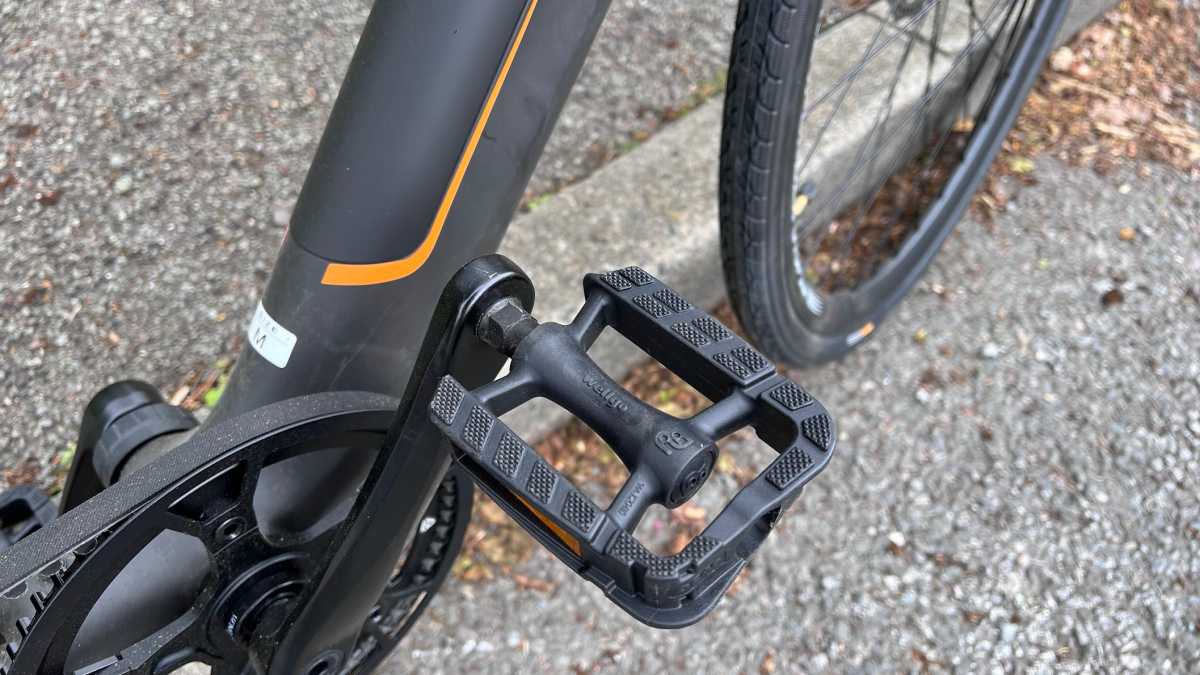
Jim Martin / Foundry
However, you do get a toolkit with the bike and a nice-looking bag to store them. That arrives attached to the frame, and there’s even a floor pump in the box which is an unusual extra that I’ve not seen before with an electric bike.
The battery clips into the frame and requires the key to remove it. You can charge it on or off the bike, and it takes around 2.5 hours if it’s completely empty.
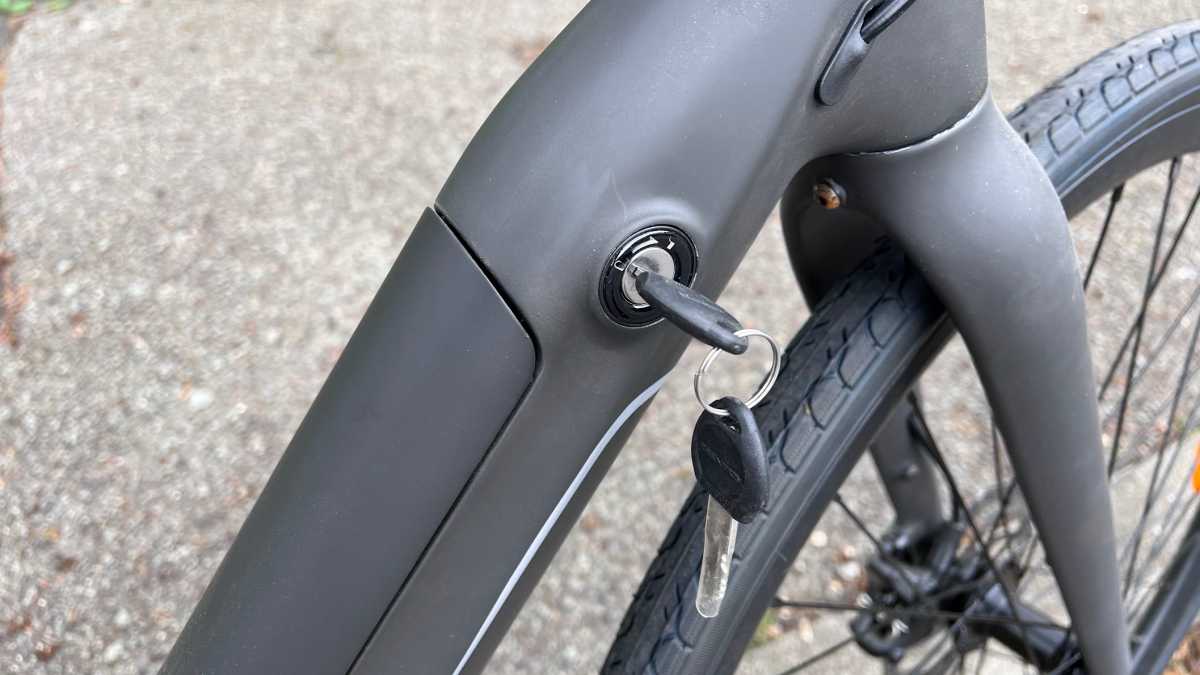
Jim Martin / Foundry
At a shade under 10Ah, its capacity is about average, and Urtopia claims a range of between 22 and 62 miles (40-100km). As ever, the actual distance you’ll get will depend upon the temperature, terrain, wind, your weight and other factors.
As mentioned, the seat post is necessarily short because of the frame design. It’s a custom-designed part with an almost triangular cross section. It has a built-in rear light and road-facing projectors which show left and right indicators. These flash when you press left or right on the direction pad.
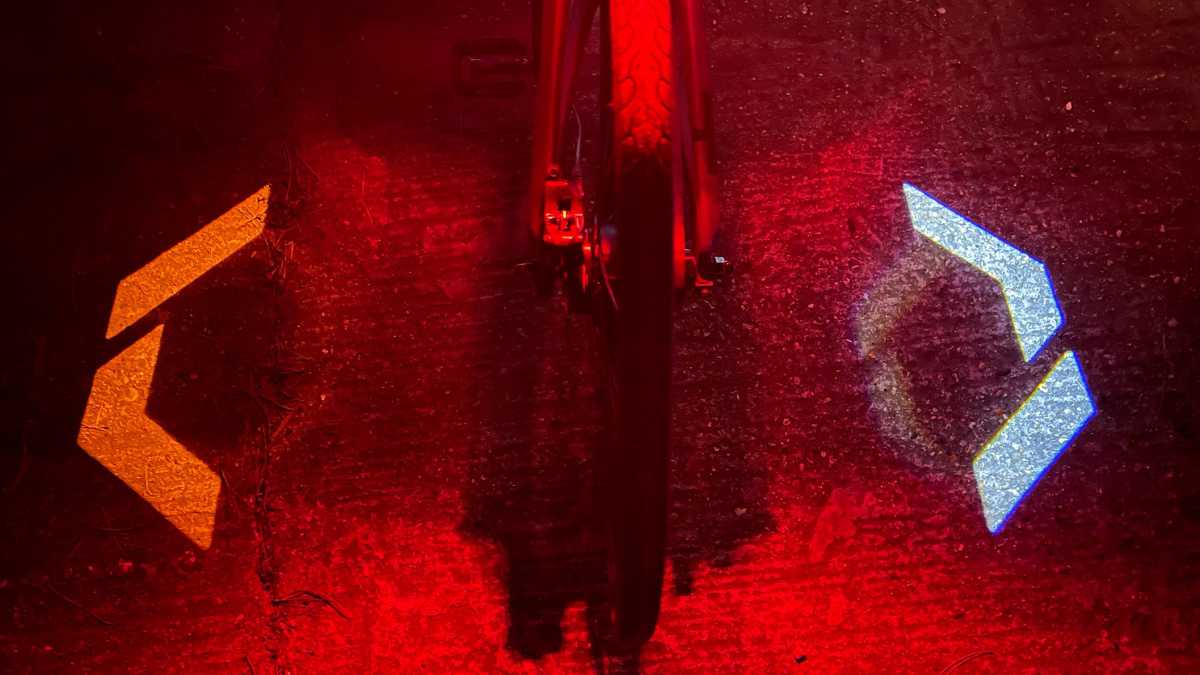
Jim Martin / Foundry
It sounds like a good idea, and they do look great at night, but they’re so dim that they’re invisible except when it’s really dark. It would have been far better if Urtopia has used LEDs that face drivers, so they can be seen during the day as well.
The front and rear lights are nice and bright and come on automatically when it’s dark if you enable Auto Light in the app. The rear light can also act as a brake light, which helps other road users know when you’re slowing down.
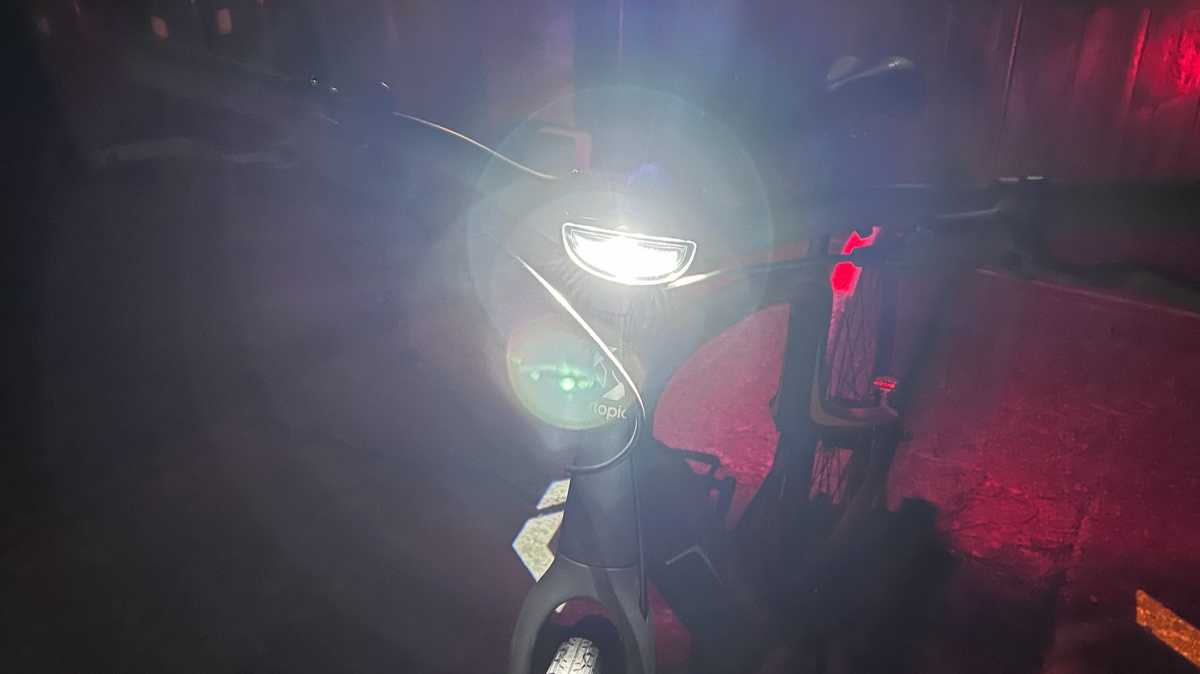
Jim Martin / Foundry
Like quite a lot of other electric bikes, the Carbon 1 uses a Gates belt instead of a chain and gears. There are pros and cons to each approach, with the belt being maintenance- and mess-free for a claimed 30,000 miles – the life of the bike, effectively.
The disadvantage is that it’s more difficult to get going from a standing start and harder to ride up hills. But of course that’s where the 250W motor comes in: this is an electric bike, after all.
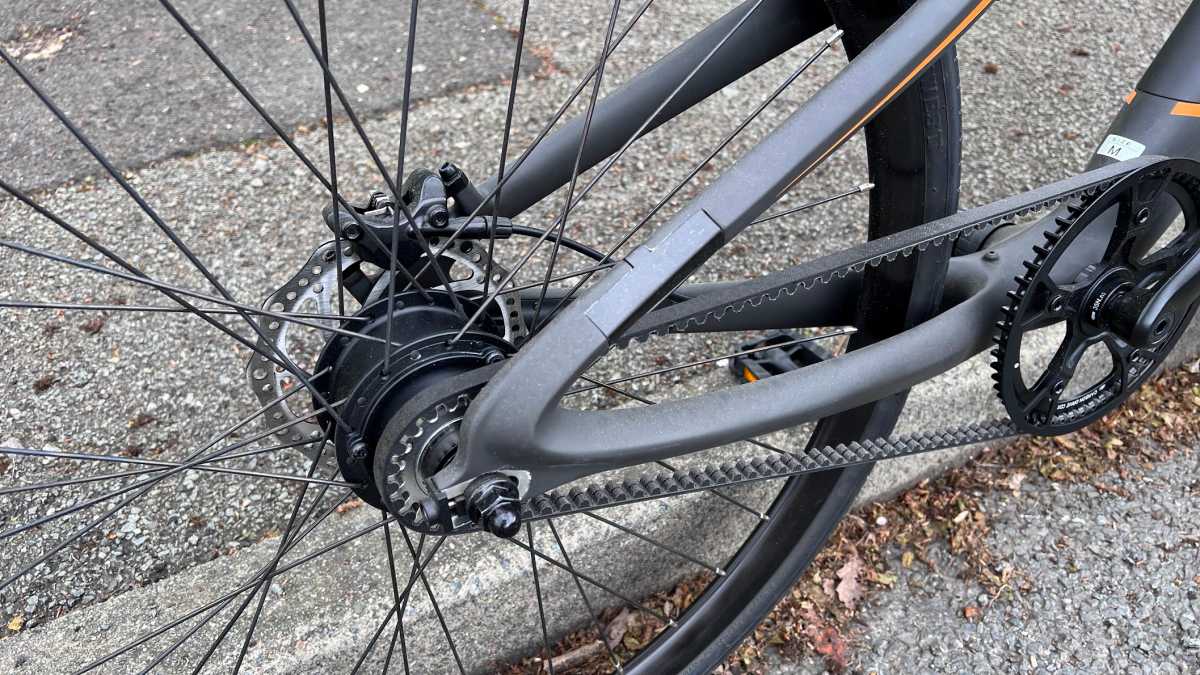
Jim Martin / Foundry
Urtopia says it’s a custom-designed model that produces up to 35Nm of torque. That’s not masses, but enough for all but the steepest hills, and the heaviest riders.
It’s governed by a torque sensor which means the power provided by the motor is proportional to the effort you put in. It makes you feel bionic, and if you don’t feel like pedalling really hard there are three power levels, plus a ‘Turbo’ mode that’s enabled by pressing and holding the up button for three seconds.
Turbo mode ignores the torque sensor and gives you maximum power regardless of how hard you’re pedalling.
Compared to a cadence (speed) sensor, torque sensors generally mean a much smoother power delivery without the noticeable jerkiness you get on cheaper electric bikes when the motor cuts in and out.
There’s no throttle, but you can hold the right-hand button down to enable walk mode which helps if you need to push the bike up a hill while walking.
Assembly is very easy: you only need to fit the front wheel and pedals. It takes about 10 minutes tops.
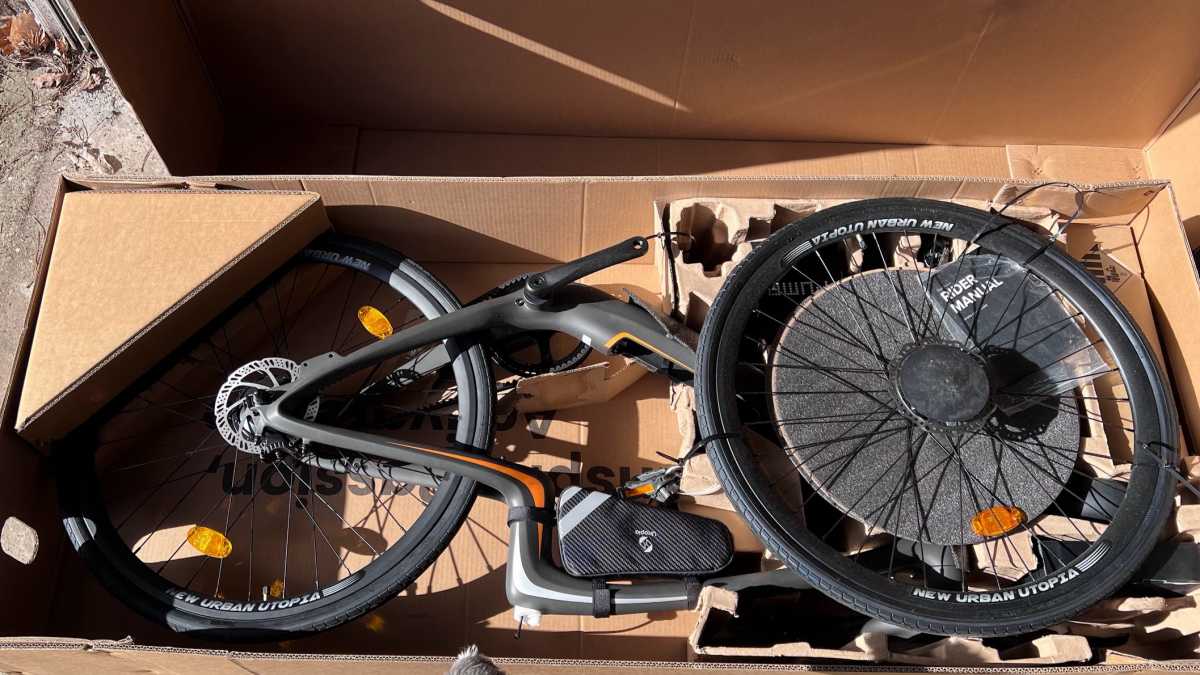
Jim Martin / Foundry
Performance
As long as you’re not too short or tall, the Carbon 1 is nice to ride on the road. Despite the lack of a traditional seat tube to brace the frame, there wasn’t any noticeable flexing, but bear in mind I am also nowhere near the maximum weight the bike can take.
I also found that, despite the height markings on the seat post, it couldn’t be inserted very far into the frame, leaving it a little too high for my liking: I really wanted to adjust it down an inch more than it was possible to. A company rep told me that it’s safe to trim off up to 40mm off the seat post, but if I was a paying customer I’d be worried about voiding the two-year warranty by doing so.
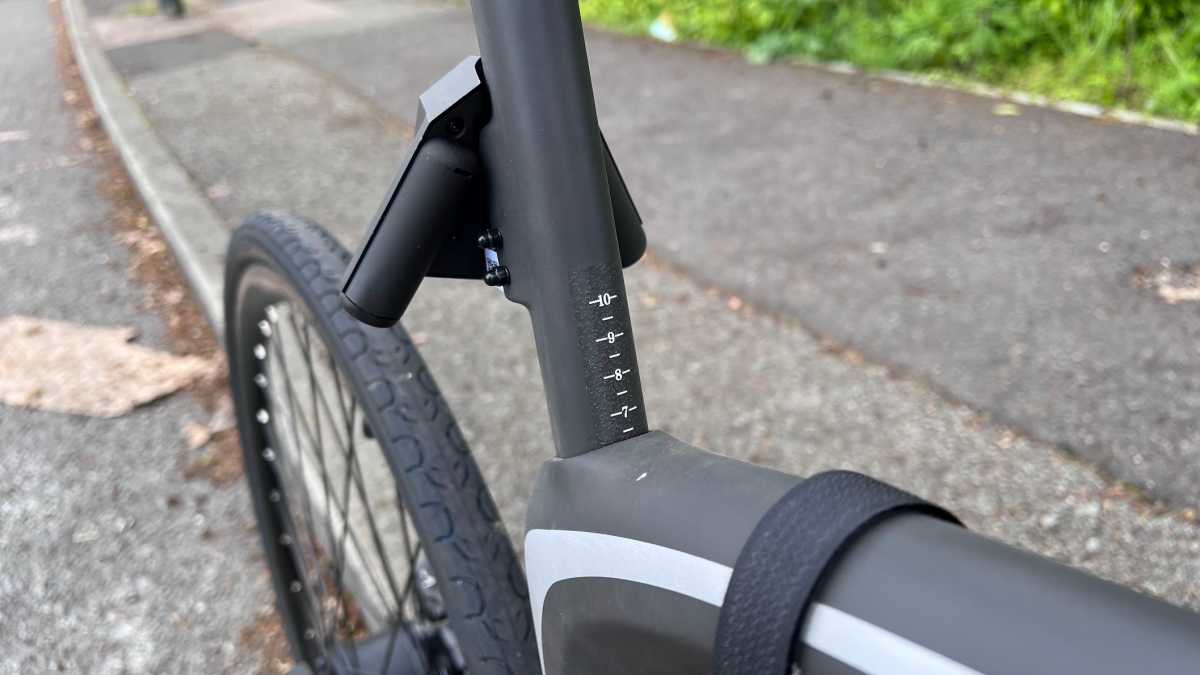
Jim Martin / Foundry
It’s also important to note that there is no adjustment of the handlebars at all, neither for height nor reach. You can move the saddle back or forward a little (as with all bikes) to compensate if the reach doesn’t suit you.
With no suspension and 700C wheels, the Carbon 1 rides a lot like a road bike: it needs smooth asphalt if you want a comfortable experience. The supplied saddle is pretty hard and uncomfortable, but Urtopia offers an ‘extra-comfort’ saddle as an accessory. It’s expensive, though, and you’re better off going to your local bike shop and finding one you like for less.
The Carbon 1 is a single-speed bike, so there’s a limit to how fast you can pedal before the cadence is simply too high. It’s geared for a top speed of about 20mph (that’s when the motor cuts out on US models), but still felt stable at around 30mph when freewheeling down hills.
In the UK, where I tested it, it was limited to 15.5mph, and I certainly wasn’t pedalling too fast at that speed.
The hydraulic disc brakes feel reassuringly powerful once they’ve bedded in, which takes a good few miles.
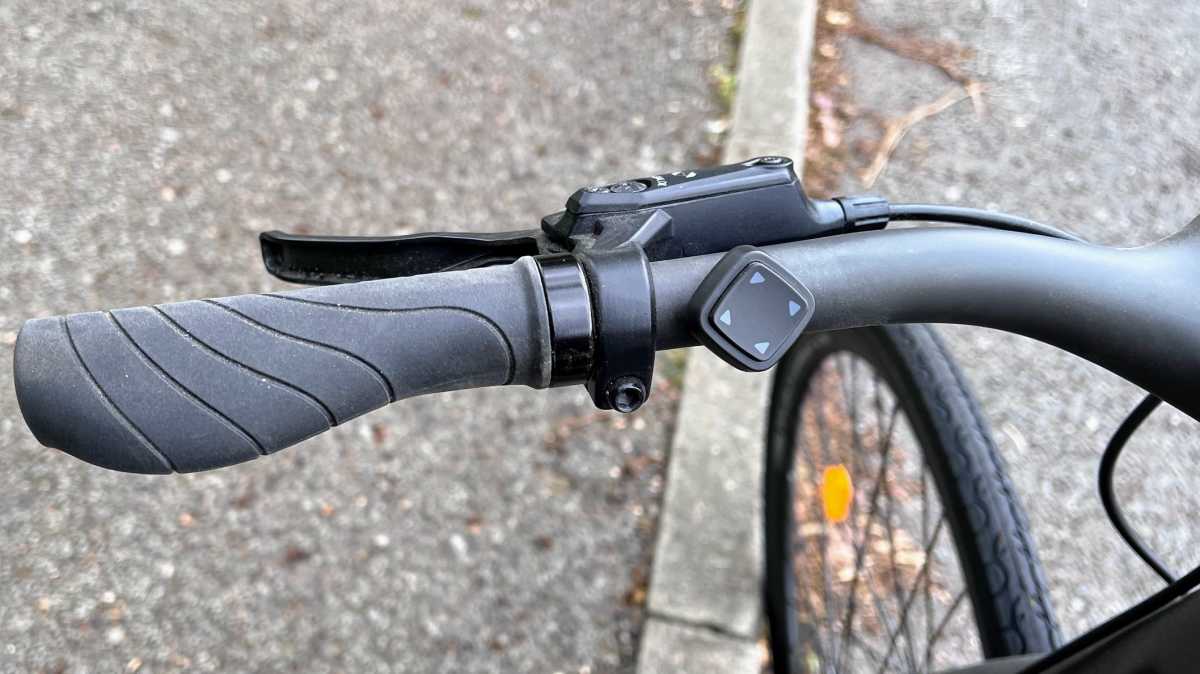
Jim Martin / Foundry
The motor is fairly quiet, even under maximum load. It isn’t silent, but certainly isn’t annoying or too loud. The fact it’s only 250W and delivers 35Nm means it isn’t hugely powerful, and you’ll still need to put in some effort when cycling up steep hills.
But that’s also a factor of the torque sensor, which means you only get maximum power when you’re pedalling hard, and that’s the same with all torque-sensor-equipped electric bikes.
When cycling on flat roads, assistance mode 1 is all you really need: it helps overcome headwinds and makes cycling feel almost effortless. But when you face a hill, you’ll almost certainly want to increase that to level 3.
Hill starts are difficult without the motor (level 0) but much easier when set to level 2 or 3. It was hard to notice any difference between level 3 and the Turbo mode.
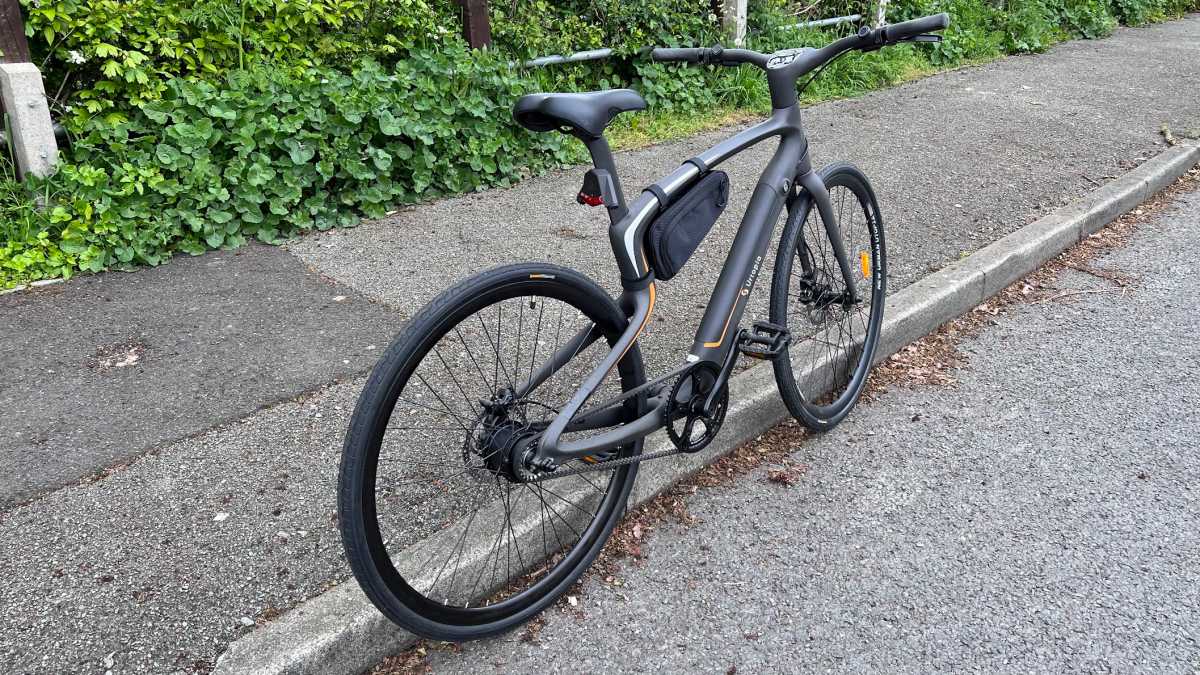
Jim Martin / Foundry
Not all of the smarts are as useful as they seem. I’ve already mentioned the projector lights aren’t bright enough to be seen during the day, but the Bluetooth speaker isn’t really loud enough to be heard clearly when riding in traffic. It’s fine if you’re riding on quiet roads, but sound quality is fairly poor, so it’s not ideal if you want to listen to music without headphones on your rides.
The fingerprint scanner worked ok most of the time, but not always. When it didn’t I had to use the app to unlock the bike. This ‘lock’ won’t stop anyone physically stealing the bike. It merely prevents anyone but you from using the motor power. And if someone does steal it, they can still ride off.
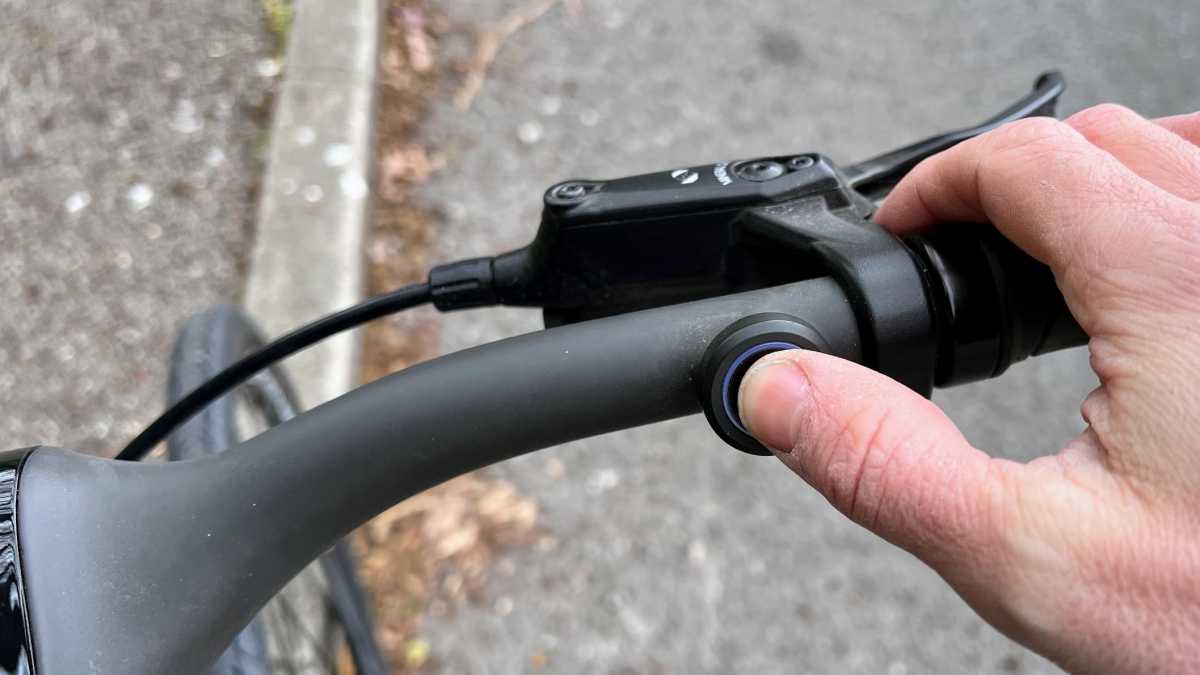
Jim Martin / Foundry
Of course, this is where there is genuinely useful tech: the GPS and eSIM mean you can see where the bike is at any time (so long as the battery still has charge). Via the app, you can set up a geofence and get notified if the bike is moved further away than the distance you set, so you’ll get an alert in the app if it is stolen.
In fact, this is one reason why it’s useful to have a ‘locked’ status: as soon as any movement is detected, you’ll get an alert on your phone. This isn’t done using GPS: an on-board motion sensor triggers as soon as the bike is moved.
The bike will also chirp when it’s moved as a warning that it’s alarmed. Just note that this happens only if you’ve put the bike in Lock mode. If it’s just in Standby, the alarm won’t be on.
Range is ok, but not outstanding. From my testing, it’s possible to run the battery flat in as little as 20 miles if you’re using…
